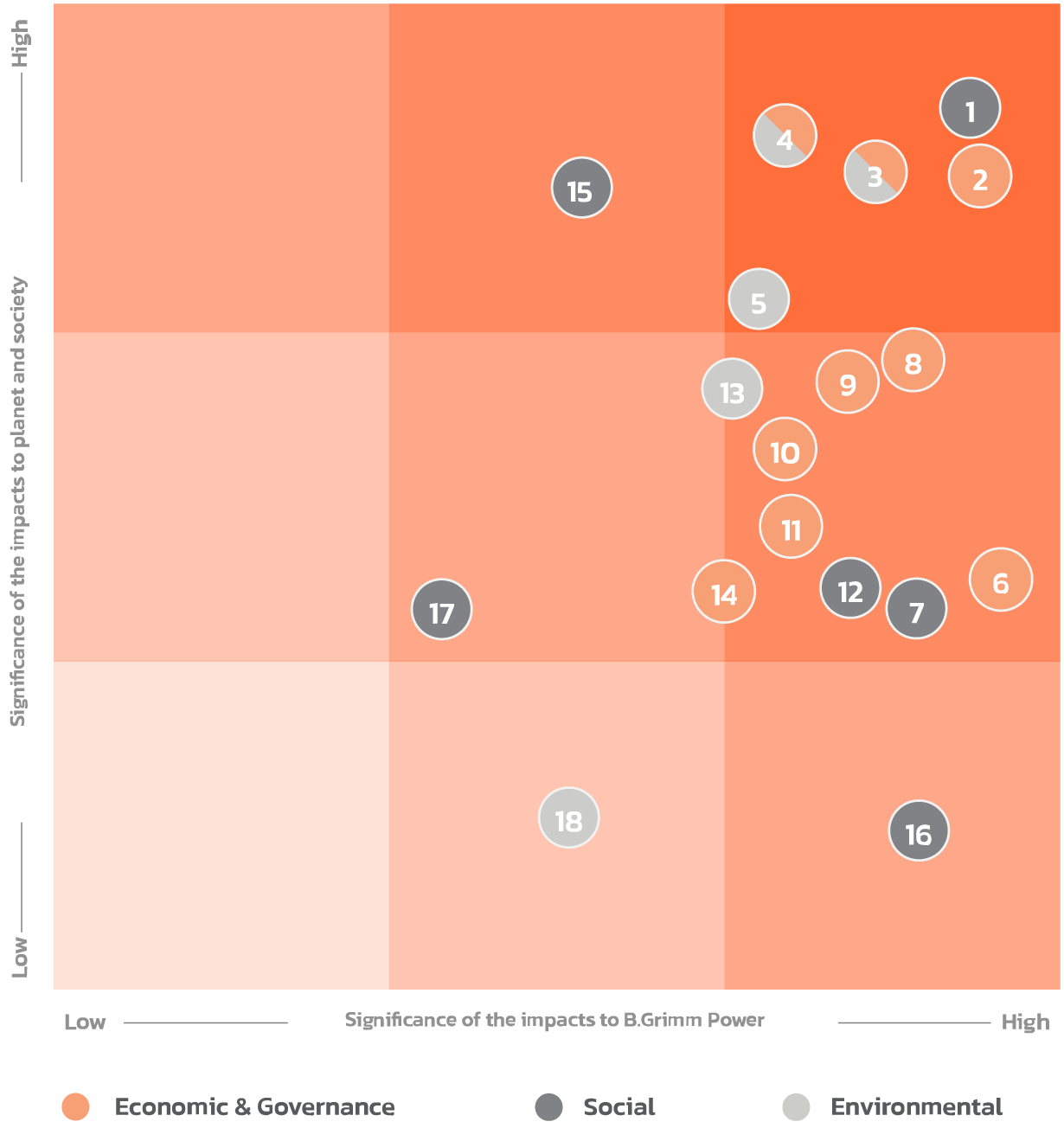Materiality Assessment
B.Grimm Power conducts an annual assessment of material sustainability topics, and reviews them in accordance with the Global Reporting Initiatives Standards (GRI), which serve as a framework for global sustainability reporting, following the GRI 3: Material Topics (2021) guidelines. This assessment considers topics that are relevant to business and covers the areas of governance, economy, environment, society and people including human rights by considering both positive and negative effects, actual and potential. We also apply the principles of double materiality to identify the impacts of our company on environment and society (outward impact), as well as its impact both financial and non-financial on B.Grimm Power (inward impact) that have or will have an impact on corporate value. This assessment incorporates the perspectives and opinions of stakeholders along the entire value chain. The assessment of the most important topics is reviewed by an external auditor and approved by the Board of Directors.
Furthermore, the assessment results directly shape corporate strategies, setting targets, performance monitoring and sustainability reporting and disclosure. This includes strategic resource allocation and risk management aligned with identified priorities and encompassing relevant topics.
| Step 1 | Step 2 | Step 3 | Step 4 | Step 5 | Step 6 | |
|---|---|---|---|---|---|---|
| B. Grimm Power | Identify Longlist Topics and Stakeholders | Shortlist Material Topics | Identify Material Topics’ Impact | Assess Impact Significance | Prioritise Material Topics | Review Prioritise Material Topics |
|
|
|
|
|
|
|
|
| Collect a long list of environmental, social, and governance (ESG) topics and identify stakeholders relevant with B.Grimm Power | Conduct Pre-interview surveys from both internal and external stakeholders to filter out ESG topics with low or no impact on the business, making our ESG shortlist topics | Identify actual and potential impacts (negative and positive) of each material topics. This includes applying the principles of Double Materiality, considering the impact on our business (inward) and from our business to outward stakeholders (outward) | Assess the level of importance of the impact, through stakeholders’ perspectives and expectations based on the severity and likelihood levels of impact for each topic | Prioritise the material topics through the materiality matrix, based on level of inward impacts (impact to business), and level of outward impacts (B.Grimm’s impact to planet and society) | Review and consider by the management committee, the Corporate Governance and Sustainability Committee, and approve by the Board of Directors respectively | |
| GRI Standards | Understand the organisation’s context | Identify actual and potential impacts | Assess the significance of the impacts | Prioritise the most significant impacts for reporting | ||
Materiality Matrix 2024

Corporate citizenship
Customer satisfaction
Energy efficiency, availability, and reliability
Low-Greenhouse Gas portfolio development
Biodiversity
Growth and economic performance
Talent management and employee welfare
Governance
Anti-corruption and transparency
Innovation and digitalisation
Cybersecurity and data privacy
Diversity and equal opportunity
Water and air management
Sustainable supply chain
Disaster and emergency management
Occupational health and safety
Vigilance against forced labor
Waste management and circularity
For more details on each step of materiality assessment process, impact assessment including the impacts of our company on environment and society (outward impact), as well as its impact both financial and non-financial on B.Grimm Power (inward impact) that have or will have an impact on corporate value, the management approach for each material topic, impacts to stakeholders, and improvements to key issues in 2024, please refer to Materiality Analysis 2024.
In addition, in-depth impact analysis on external stakeholders can be found in the BGRIM Impact Assessment for External Stakeholders.

